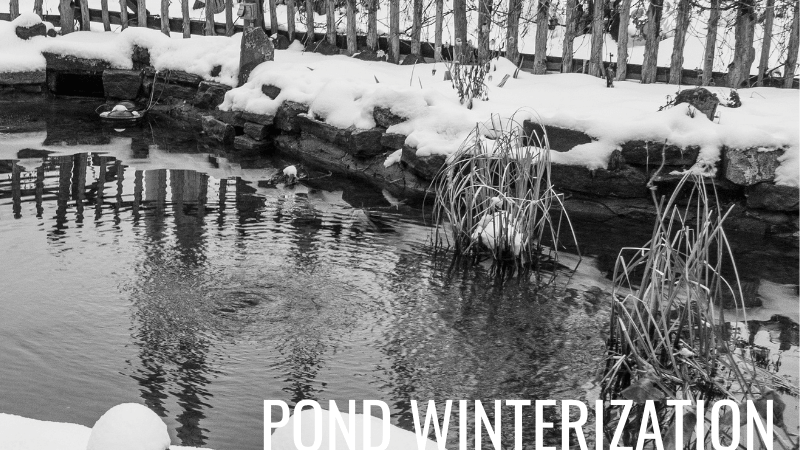How to Winterize a Pond in 4 Important Steps
Pond Academy is reader-supported. Buying through links on our site may earn us an affiliate commission. As an Amazon Associate I earn from qualifying purchases.
Winterizing your pond is important if you live in colder climates.
Especially if you have fish, aquatic plants, and expensive equipment in your pond to maintain.
In this step-by-step guide, you'll learn how to winterize a pond in no time at all and ensure it's ready for the cold weather ahead!
Let's get started.
How to Prepare a Pond for Winter Step-by-Step

![]() Tip
Tip
When you winterize your pond will vary by location, the weather, pond setup, and other factors, including the personal choice of the pond owner. I personally like to start the winterization process in Fall, right after or before the first frost hits.
Step 1: Remove Debris & Sludge
The first step in preparing your pond for winter is to remove debris (leaves from trees and other organic material) and muck from your pond.
Start from the top of your pond, removing any floating debris with a pond net or pond rake, and work your way down.
If you run a pond skimmer or have a pond net placed over the top of your pond, this process should be pretty easy.
Once you've removed all of the floating debris, it's time to tackle the sludge and muck covering the bottom of your pond.
I recommend using a pond vacuum to tackle this problem! They make it extremely easy to clean the bottom of your pond without having to drain the water.
Pond vacuums come with many different features and attachments, so if you don't already have one, check out our guide to the best pond vacuums available today.
Keep in mind, if you have a wildlife pond or just a thin layer of sludge, it's fine to leave it.
Step 2: Winterize Pond Plants
Next, we need to properly prepare your pond plants for the coming winter.
Start by trimming dying or dead foliage from your plants. This will help prevent excess organic debris from sinking to the bottom of your pond and adding to the sludge problem.
![]() Tip
Tip
If you fertilize your plants during the spring and summer months, stop once the water temperature falls below 60 F (16 C).
Any pond plants that are not hardy in your region will need to be brought indoors, or treated as annuals and replanted next spring.
For most winter-hardy plants you have in your pond, you can overwinter them by:
- If you haven't already, trim any dead foliage from the plants. For hardy water lilies, trim the plants down to their crowns.
- Lower the plant containers to the bottom of the deepest part of your pond (at least 2 1/2 feet deep).
- Return plants to their original location after the pond ice has melted in Spring.
Some marginal pond plant, for example, Creeping Jenny, can be left where they are during winter. You'll just want to trim the plants to just above the water level.
Check out our guide on how to keep pond plants alive over winter for more information!
Step 3: Remove & Clean Equipment
Now, we need to winterize any pond equipment or water features you may have, including the pump, filter, skimmer, and so on.
If you live in moderate climate zones and your pond doesn't completely freeze solid, you could potentially leave your pump running. Some people prefer to leave their pump and waterfall running to improve oxygenation as it may be enough to keep a hole in the ice.
If you decide to leave these components running during winter, you will need to check on your pond often! Especially check for ice dams forming, which can divert your pond water out of your pond.
With that said, in colder climates where your pond has the potential to freeze, it's a good idea to shut your pond down and unhook your pump, filter, fountain, and other equipment.
- When storing your submersible pump for the winter, first clean it, then place it in a bucket of water in your house or garage to prevent the seals from drying out. If your pond doesn't completely freeze, you can place the pump in the deepest part of your pond over winter, as well.
- Any filter media you have in your pond should be cleaned, as well, and stored in your garage or house.
- Drain the water from any plumbing to prevent the water from freezing and expanding, potentially cracking the pipes.
Step 4: Oxygenate the Water
This step is crucial if you have koi or other fish in your pond. Essentially, you need to make sure the surface of your pond doesn't completely freeze over, preventing oxygen from entering the water and harmful gases from releasing.
In milder climates, you can usually get away with just running a pond aerator. This can provide enough movement to stop the surface from freezing over while also adding oxygen to your pond.
If your pond is prone to freezing over, then you should use a pond heater or de-icer. This will help keep a hole in the ice allowing for proper gas exchange.
![]() Tip
Tip
If your fish pond does freeze over, pour hot water over the ice to create a hole. Do NOT pound on the ice to break a hole in it. This will cause unneeded stress for your fish.
Optional Winterizing Steps
Some addition, yet optional, steps I recommend performing for the healthiest pond ecosystem include:
- Test Water Quality: After winterizing your pond, it's a good idea to perform a water quality check to make sure parameters like ammonia, nitrites, nitrates, and pH are where they should be.
- Cover Your Pond: Covering your backyard pond with pond netting or mesh dome will help keep debris from falling or blowing into the pond over the winter. This will make opening your pond in Spring much easier and keep the water quality high over winter. Of course, this may not be an option for larger ponds.
- Add Cold Water Bacteria: Cold Water Bacteria, designed to work in temps below 50 F (10 C), may help improve water quality by digesting any debris that finds its way into your pond during the winter months.
Once completed with these steps, your garden pond should be ready for winter! Be sure to check on your pond regularly throughout the winter months to ensure nothing out of the ordinary has happened.
Get Our Best Pond Tips Sent to Your Inbox for Free!
Join thousands of others and learn from our decades of pond building and maintenance experience! Your pond will thank you!
By subscribing you agree to receive emails from PondAcademy.com. We will always respect your privacy and you can unsubscribe at any time.
Pond Winterizing Kit
So, what's in my pond winterizing tool kit? Here are some of the products and tools I use when winterizing a pond. Click each product to view it on Amazon.
- Pond Net: Great for removing debris and organic material floating in backyard ponds and water gardens.
- Pond Vacuum: Used to suck up the muck and sludge from the bottom of your pond (and many other uses, as well).
- Pruning Shears: To trim down and remove dead foliage from plants.
- Pond Aerator: To supply vital oxygen to your pond and help keep a hole in the icy surface to allow for proper gas exchange.
- Pond De-Icer: In freezing cold climates, a pond de-icer might be necessary to create a small opening on the icy surface.
- Pond Netting: Protects the pond in fall and during winter from falling leaves and other debris.
- Pond Water Quality Test Kit: Important to make sure the factors that affect your pond water quality are within range.
- Cold Water Bacteria: May help improve water quality and clarity by breaking down and digesting debris that enters your pond.
Do You Need to Winterize Your Pond?
A good rule of thumb is if you live in an area with freezing temperatures during the winter, then you'll want to winterize your pond - whether it's an inground or above ground pond, especially if you have fish and/or pond plants that you want to survive during these colder months.
For example, you will need to make sure your pond plants are prepared for the impending cold weather, whether that be sinking them in the deepest part of your pond, taking them inside, or treating them as annuals and replanting them in Spring.
Pond fish need a place in your pond that won't completely freeze over to enter torpor (similar to hibernation), and you'll need a hole in the icy surface to allow for proper gas exchange.
If you live in warmer climates where the water has no chance of freezing over, you can get by without winterizing your pond. However, you can still follow some of the steps below as part of an annual maintenance plan for your pond.







